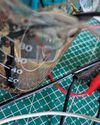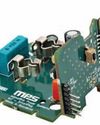TOUCH TO ROLL: A Decoder-Based Dice
Electronics For You
|April 2025
Electronic dice, or e-dice, are widely used today, but creating a design replicating the anticipation and randomness of a physical dice roll comes with its challenges.

This device achieves that effect by generating a rolling motion that lasts approximately four seconds, though the duration can be adjusted by modifying the rolling steps.
A 3-to-8 decoder (IC 74LS138) displays a valid dice face, with combinational AOI logic (AND, OR, and INVERT gates) ensuring only valid outputs. Seven individual LEDs, arranged to represent numbers 1 through 6, replicate the appearance of a traditional dice. The ESP32 microcontroller brings the design to life, handling random number selection and creating a realistic rolling effect, making this an excellent case study in digital circuit design.
Fig. 1 shows the prototype with the rolling clock, while Fig. 2 presents a block diagram of the system. Table 1 lists the components required to build this device.
 The main components of this device are the ESP32 board and the ICs 74LS138, 74LS260, 74LS04, and CD4075. The truth table for the decoder IC 74LS138 is provided in Table 2.
The main components of this device are the ESP32 board and the ICs 74LS138, 74LS260, 74LS04, and CD4075. The truth table for the decoder IC 74LS138 is provided in Table 2.The ESP32 board is the core of the device. It is used for the following tasks:
Detecting the closure of the path that activates the dice roll.
Introducing a rolling step of a few seconds (four seconds in this case).
Generating a 3-bit random number.
Dit verhaal komt uit de April 2025-editie van Electronics For You.
Abonneer u op Magzter GOLD voor toegang tot duizenden zorgvuldig samengestelde premiumverhalen en meer dan 9000 tijdschriften en kranten.
Bent u al abonnee? Aanmelden
MEER VERHALEN VAN Electronics For You

Electronics For You
Tech Majors Are Racing TOWARDS NET-ZERO - What About You?
Apple, Microsoft, Amazon, Google, Infosys, Wipro—global and Indian firms are heading closer to achieving net-zero emissions, a mandate to combat climate change. Here is what you need to know to start your journey...
12 mins
December 2025

Electronics For You
Miniature IoT WATER TDS And LEVEL MONITOR Cum CONTROLLER
For setups that rely on stored water, clear awareness of tank level and water quality is essential.
3 mins
December 2025

Electronics For You
The Impact Of GENERATIVE AI On The Future Of AUTOMOTIVE AND EVs
Autonomous vehicles, connected ecosystems, and smart factories are only the beginning. Generative Al is pushing the auto industry beyond predictions into a bold era of creativity-from EV design to real-time diagnostics and showroom automation. Here is how GenAl is reshaping innovation across the automotive value chain.
8 mins
December 2025

Electronics For You
How AI Tools Are Making SOFTWARE DEVELOPMENT BETTER
AI is reshaping how we code, debug, and collaborate. From Copilot to automation, it is changing software development in ways worth exploring.
3 mins
December 2025
Electronics For You
How AI Tools Are Making SOFTWARE DEVELOPMENT BETTER
AI is reshaping how we code, debug, and collaborate. From Copilot to automation, it is changing software development in ways worth exploring.
3 mins
December 2025

Electronics For You
5 Interesting Reference Designs FOR SMART HOMES
Smart home devices are transforming the way people interact with their appliances. They make homes more convenient, secure, and energy-efficient. From smart plugs and energy monitors to smart locks and thermostats, reference designs help design engineers create connected products that are easy to use, consume less power, and are reliable. These designs allow you to control devices remotely, track energy use, extend battery life, and automate routines. They provide practical solutions for upgrading homes and small commercial spaces without major modifications.
3 mins
December 2025

Electronics For You
Fancy USB LED VASE
This USB LED vase is a simple yet elegant device that fuses art with electronics to create a decorative lighting display. Powered directly from a standard USB port, it uses readily available components such as MOSFETs, resistors, capacitors, and LEDs to produce a striking, dynamic sequence of lights.
3 mins
December 2025

Electronics For You
"WHAT OTHERS SELL IN FOUR BOXES WE BUILT IN ONE"
Years of custom field work are shaping a product line with its own cloud, its own hardware, and a market that is now beginning to recognise its value.
8 mins
December 2025

Electronics For You
BUILD LARGE LANGUAGE MODELS
Large language models are machine learning models designed for a range of language-related tasks such as text generation and translation. Here’s how open source software can help you build your own large language model.
6 mins
December 2025

Electronics For You
Rare Earth Or Rare Ingenuity? India Remains Between The Two
With China firmly controlling rare earth exports, India confronts a critical moment in its technological trajectory.
8 mins
December 2025
Listen
Translate
Change font size

